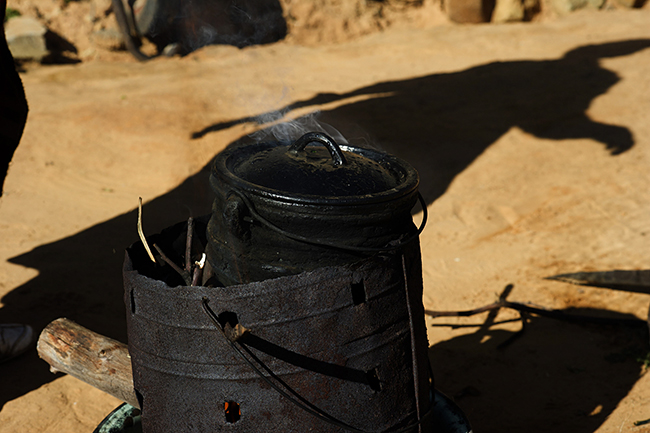Homestead gardening brings hope as Lesotho seeks to adapt to climate change
Campaign aims to improve food security and diets of most vulnerable
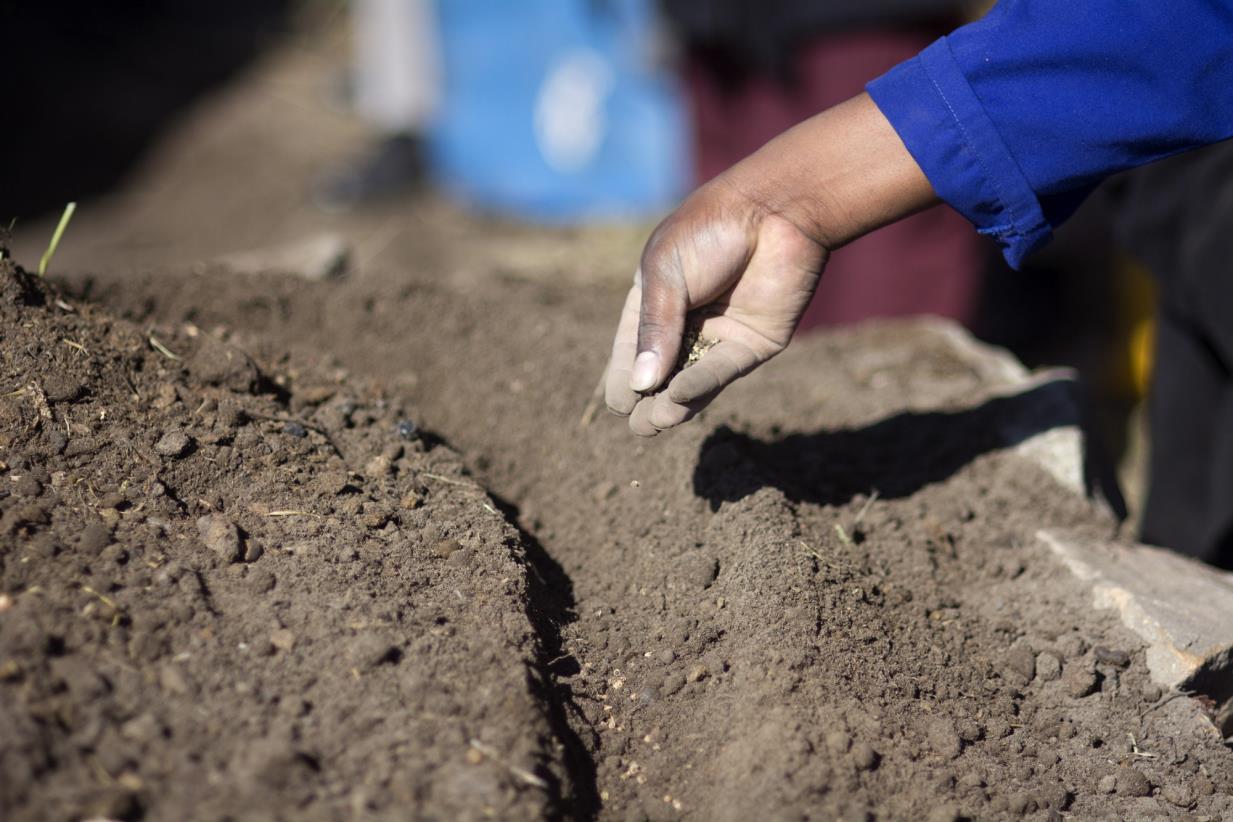
Close-up of a keyhole garden in Morija, Maseru District, Lesotho.
©Photo: ©FAO/Rodger Bosch
27/10/2015
27 October 2015, Leribe, Lesotho - Ask 90-year-old Rammitsane Matela how climate conditions have changed over the years for the farmers in the fields of rural Lesotho and he does not need to stretch his memory far to find the answer.
"Heavy rains and drought are things that started recently," he says of the extreme weather events which, as in so many other parts of the world, are increasingly afflicting Lesotho, a landlocked country in southern Africa.
Flat-topped hills and mountains, rocky crevices and dongas - deep gullies formed by soil erosion - mark much of Lesotho's landscape, giving it a lunar-like appearance. During strong downpours, the dongas turn into torrents that drain away the increasingly scarce fertile topsoil from cultivable tracts of land that lie in the valleys.
Lesotho struggles with poverty, malnutrition, high HIV infection rates, unemployment and soil erosion. Declining harvests due to the combination of inadequate production practices and the impact of climate change are compounding the country's problems, pushing many rural communities further into food and nutrition insecurity.
Better crops while saving soil and water
Part of the solution lies in creating opportunities for households to produce their own nutritious food and for them to do this by using precious resources such as soil and water in a sustainable way.
FAO is working with the Government of Lesotho, non-governmental organizations and other United Nations agencies on a resilience strategy to help adapt the country's farming system to changing climate conditions such as erratic rain patterns and higher temperatures. The initiative includes promoting homestead gardening and adopting innovative techniques such as the construction of keyhole gardens.
These are raised plots - around 2 metres in diameter - consisting of an outer stone wall packed with several layers of soil and rich organic material such as manure, compost or ash that surround a cylindrical basket filled with porous material such as cotton sacks stones reed, maize, sorghum and clay pots.
The keyhole garden's structure allows for the planting of carrot, beetroot, spinach and other vegetables next to each other in a way that can improve soil fertility and capture moisture. The garden can also be easily covered to protect crops from winter frost and the drying effects of the wind.
For 65-year-old grandmother, Makompi Mahlomola, from the village of Komeng in Lesotho's Leribe district, the keyhole garden is the only readily available source of nutritionally diverse food for her household which includes four young children.
"My main problem is that nobody in the family is working. Our home garden really helped us because we can grow vegetables for longer, even when there is a dry spell. Spinach is especially good because it grows all year round," she explains.
Targeting the young
In promoting better nutrition and developing the skills to increase the production and variety of vegetable crops through homestead gardening, FAO, the Government of Lesotho and their partners are also reaching out to rural communities, especially children, young people and the most vulnerable.
Katiso Sekete, agriculture teacher at Thabang High School, gives a lesson on building keyhole gardens (©FAO/Rodger Bosch).
"The challenge is to eliminate hunger and this is not a challenge that can be accomplished by actors working in isolation," says Borja Miguelez, FAO Emergency and Rehabilitation Coordinator in Lesotho.
He explains that FAO works primarily with extension services, government officials from the ministries of agriculture and education, as well as non-governmental organizations and other UN agencies.
In one such joint effort, FAO, with the support of the Government of Lesotho, the European Union, USAID and UKAID, has developed colourful posters on growing food at home, improving yields, diversifying crops and eating healthy. These messages have been harmonized with the food security stakeholders in the country. The materials are being distributed to schools, extension workers and partners in English and in the local Sesotho language.
The aim of the campaign is also to encourage and teach people to build keyhole gardens at home and at school, improve diversity of crops and optimize the use of food. At Thabeng High School in Morija, a town located 35 kilometres south of the capital of Lesotho, Maseru, pupils have built their own keyhole garden as part of their training.
"Most of the kids in our school are orphans. There is no one who can provide them with money or who can provide them with food, so in the school year we provide them with the basic skills in agriculture which they can use to produce something," says Katiso Sekete an agriculture teacher at Thabeng High School.
Leribe District, Mahobong. Students at Ikhetheleng Primary School watch their classmates water their trench garden (©FAO/Rodger Bosch).
Part of the challenge is to persuade rural communities to adopt the new techniques, according to Ntitia Tuoane, Acting Director Field Services in Lesotho's Ministry of Agriculture and Food Security. "There's always a bit of fear of jumping into it, so people always watch other people to see if there are successes," he says.
Malijo Matela, whose first name means "mother of food", is 22 years old and finishing high school. For her and her household, the keyhole garden she tends has made life much easier. "Before the home gardening I would not know what to cook and sometimes I would go to bed hungry, but now things are easier because I have vegetables," she says.
Vegetables grown using a keyhold garden in Betha Betha village, Malaoaneng District, cooking in a pot on a fire at a homestead (©FAO/Rodger Bosch).
"Heavy rains and drought are things that started recently," he says of the extreme weather events which, as in so many other parts of the world, are increasingly afflicting Lesotho, a landlocked country in southern Africa.
Flat-topped hills and mountains, rocky crevices and dongas - deep gullies formed by soil erosion - mark much of Lesotho's landscape, giving it a lunar-like appearance. During strong downpours, the dongas turn into torrents that drain away the increasingly scarce fertile topsoil from cultivable tracts of land that lie in the valleys.
Lesotho struggles with poverty, malnutrition, high HIV infection rates, unemployment and soil erosion. Declining harvests due to the combination of inadequate production practices and the impact of climate change are compounding the country's problems, pushing many rural communities further into food and nutrition insecurity.
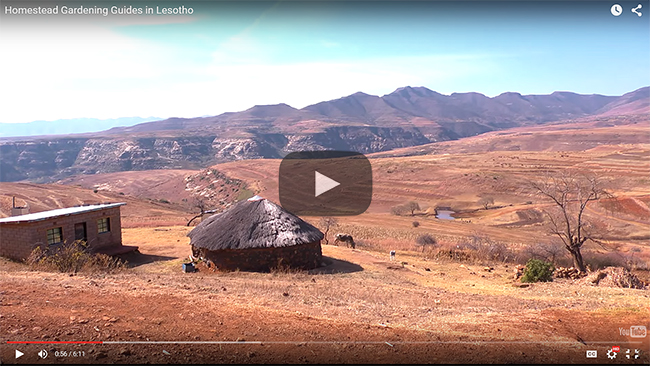 |
Better crops while saving soil and water
Part of the solution lies in creating opportunities for households to produce their own nutritious food and for them to do this by using precious resources such as soil and water in a sustainable way.
FAO is working with the Government of Lesotho, non-governmental organizations and other United Nations agencies on a resilience strategy to help adapt the country's farming system to changing climate conditions such as erratic rain patterns and higher temperatures. The initiative includes promoting homestead gardening and adopting innovative techniques such as the construction of keyhole gardens.
These are raised plots - around 2 metres in diameter - consisting of an outer stone wall packed with several layers of soil and rich organic material such as manure, compost or ash that surround a cylindrical basket filled with porous material such as cotton sacks stones reed, maize, sorghum and clay pots.
The keyhole garden's structure allows for the planting of carrot, beetroot, spinach and other vegetables next to each other in a way that can improve soil fertility and capture moisture. The garden can also be easily covered to protect crops from winter frost and the drying effects of the wind.
For 65-year-old grandmother, Makompi Mahlomola, from the village of Komeng in Lesotho's Leribe district, the keyhole garden is the only readily available source of nutritionally diverse food for her household which includes four young children.
"My main problem is that nobody in the family is working. Our home garden really helped us because we can grow vegetables for longer, even when there is a dry spell. Spinach is especially good because it grows all year round," she explains.
Targeting the young
In promoting better nutrition and developing the skills to increase the production and variety of vegetable crops through homestead gardening, FAO, the Government of Lesotho and their partners are also reaching out to rural communities, especially children, young people and the most vulnerable.
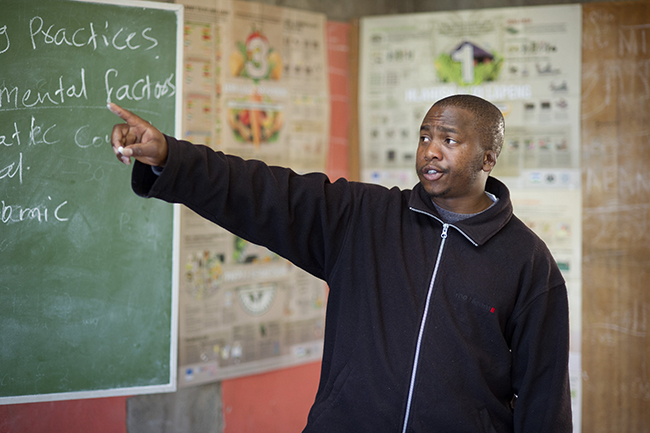 |
"The challenge is to eliminate hunger and this is not a challenge that can be accomplished by actors working in isolation," says Borja Miguelez, FAO Emergency and Rehabilitation Coordinator in Lesotho.
He explains that FAO works primarily with extension services, government officials from the ministries of agriculture and education, as well as non-governmental organizations and other UN agencies.
In one such joint effort, FAO, with the support of the Government of Lesotho, the European Union, USAID and UKAID, has developed colourful posters on growing food at home, improving yields, diversifying crops and eating healthy. These messages have been harmonized with the food security stakeholders in the country. The materials are being distributed to schools, extension workers and partners in English and in the local Sesotho language.
The aim of the campaign is also to encourage and teach people to build keyhole gardens at home and at school, improve diversity of crops and optimize the use of food. At Thabeng High School in Morija, a town located 35 kilometres south of the capital of Lesotho, Maseru, pupils have built their own keyhole garden as part of their training.
"Most of the kids in our school are orphans. There is no one who can provide them with money or who can provide them with food, so in the school year we provide them with the basic skills in agriculture which they can use to produce something," says Katiso Sekete an agriculture teacher at Thabeng High School.
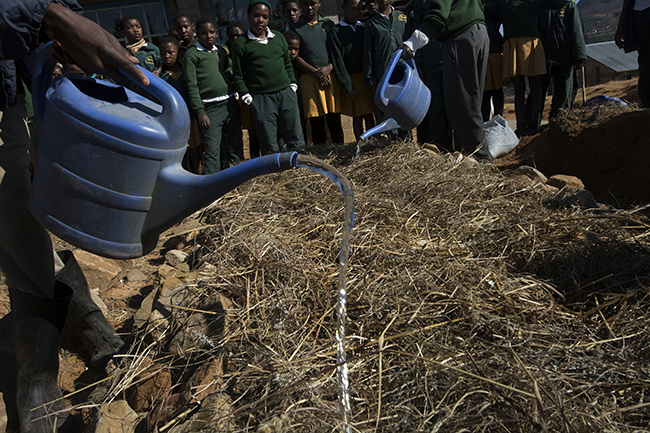 |
Part of the challenge is to persuade rural communities to adopt the new techniques, according to Ntitia Tuoane, Acting Director Field Services in Lesotho's Ministry of Agriculture and Food Security. "There's always a bit of fear of jumping into it, so people always watch other people to see if there are successes," he says.
Malijo Matela, whose first name means "mother of food", is 22 years old and finishing high school. For her and her household, the keyhole garden she tends has made life much easier. "Before the home gardening I would not know what to cook and sometimes I would go to bed hungry, but now things are easier because I have vegetables," she says.
|
Contact
Peter Mayer FAO News and Media (Rome) (+39) 06 570 53304 [email protected]

